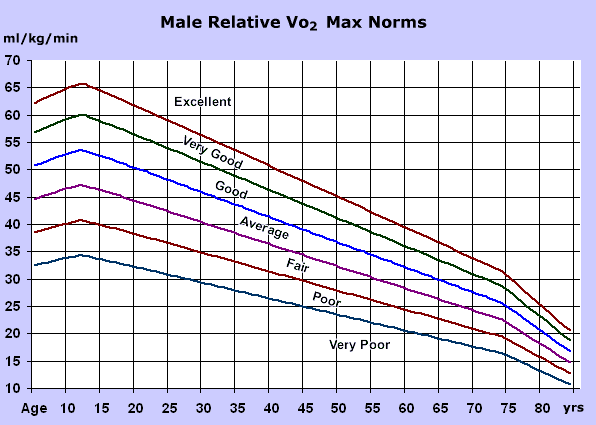Overview
The ability to exercise is determined by the ability to transport fuel and oxygen to and waste products from the cells. In the healthy human, this process is limited by the cardiovascular system's performance and not by that of the respiratory system. The maximum amount of oxygen which can be transported per minute is termed the VO2 max. This is obviously important in determining performance as it cannot be exceeded but equally important is the maximum sustainable amount of work that can be performed.
The sustainability of exercise is, at least in the short to medium term, determined by whether the energy to perform the work is mainly supplied by aerobic metabolism (ie metabolism when oxygen is plentiful) or anaerobic metabolism. This is not an either/or situation as anaerobic metabolism supplements aerobic metabolism at the cellular level even at relatively low workloads, however at these workloads, the products of anerobic metabolism are further metabolised by the liver and will remain at a constant low level. This is demonstrated by lactate being found in the blood of a person at rest, but this lactate remaining at a constant & low level.
Lactic acid causes the blood to become more acidic and the acidity of the blood will affect the performance of all the body's organs. In our context, we are mainly concerned with the effect that the lactate acidosis has on muscle performance. At low levels of work, the lactate concentration may, depending on the workload, initially rise but will then remain constant. These workloads can be sustained for a long period of time.
When the products of anaerobic metabolism (primarily lactate) begin to increase whilst at a constant workload, it will be only a matter of time until that workload can no longer be sustained. The threshold at which this increase occurs is referred to as the anaerobic threshold and occurs at approx 60% of the VO2 max. CPET (cardio-pulmonary exercise test) can infer these thresholds by measuring data on O2 consumption and CO2 production at various workloads. The most common way of doing this is with a static cycle with an increasing resistance and a combined gas content and volume analyser. Other, less accurate, ways of inferring these thresholds do exist and these work by measuring heart rate and running speed and correlating this with the work required to run at a certain pace.
As the normal lungs will cause the blood entering the left side of the heart to be fully saturated with oxygen, when exercising, the only way to supply the muscles with more oxygen is by the cardiovascular system pumping more blood & the exercising muscle extracting more oxygen from the blood passing through it. The cardiovascular system transports more oxygen by the heart beating more frequently and by increasing the volume of blood pumped per beat (stroke volume). Both these mechanisms are limited- heart rate by age (hence the equation for maximum heart rate of 220-age in yrs) and stroke volume by anatomy. Training can increase the possible stroke volume up to it's anatomical & physiological maximum and this explains the observation of slower heart rates in trained athletes- fewer beats are required to pump the same amount of blood if each beat pumps more blood. Changes in the exercising muscle, it's blood supply and the efficiency of the muscle also contribute to the positive effect of training on performance.
The anaerobic threshold needs not to be exceeded in order to perform effectively in an event lasting more than a few minutes. In practical terms, knowing ones heart rate at the anaerobic threshold can help in knowing how much work can be undertaken sustainably.
Application to rowing
Being a better rower is obviously about improving one's technique, but the importance of training the cardiovascular system can't be overstated. The most time-efficient way of doing this is by High Intensity Interval Training or HIIT. Many different modes of exercise are suitable for HIIT, for example rowing ergometers and spinning bikes. Fartlek is also arguably an early type of HIIT https://en.wikipedia.org/wiki/Fartlek. HIIT in its various forms involves several repetitions of high-intensity exercise separated by medium intensity exercise for recovery (and a suitable warm-up & warm-down) and many different regimes are promoted https://en.wikipedia.org/wiki/High-intensity_interval_training. The HIIT principle has been taken to the extreme with Super High Intensity Interval Training where the load on the bike etc is greater than that which is the maximum normally acheivable (obviously the duration is extremely short). 2-3 HIIT sessions a week have been shown to improve cardiovascular fitness in as short a time as 4-6 weeks, but it's important that other types of exercise are used in the training regime as well.
We have found that it more efficient in terms of boat speed to increase the effort in the drive as much as possible and keeping a long stroke. The commonly held belief about making a boat go faster by increasing the stroke rate may work in narrower, finer boats but is flawed when applied to the heavier Celtics. Fast Celtic crews will be stroking at a faster rate but the increase in stroke rate will initially occur naturally as a result of an increase in boat speed shortening the time taken for the drive. Additional speed is progressively more difficult to gain as the speed increases and so just focussing on stroking more quickly invariably compromises the drive and shortens the recovery phase. A good analogy is felt on an ergo by increasing the damper setting to maximum- it's very difficult to maintain a high stroke rate in this case & increasing the stroke rate by accelerating the recovery does little to increase boat speed whilst appreciably increasing the workload. This is apparent in the increase in heart rate that occurs with such strategies and leads to the rower exceeding their anaerobic threshold with little benefit in terms of boat speed. Having said that, a fitter crew (ie with a higher anaerobic threshold) will be able to maintain the technique and power in the drive at a faster stroke rate- that's why a younger crew with their potential to have a much higher anaerobic threshold should always beat an older crew..
